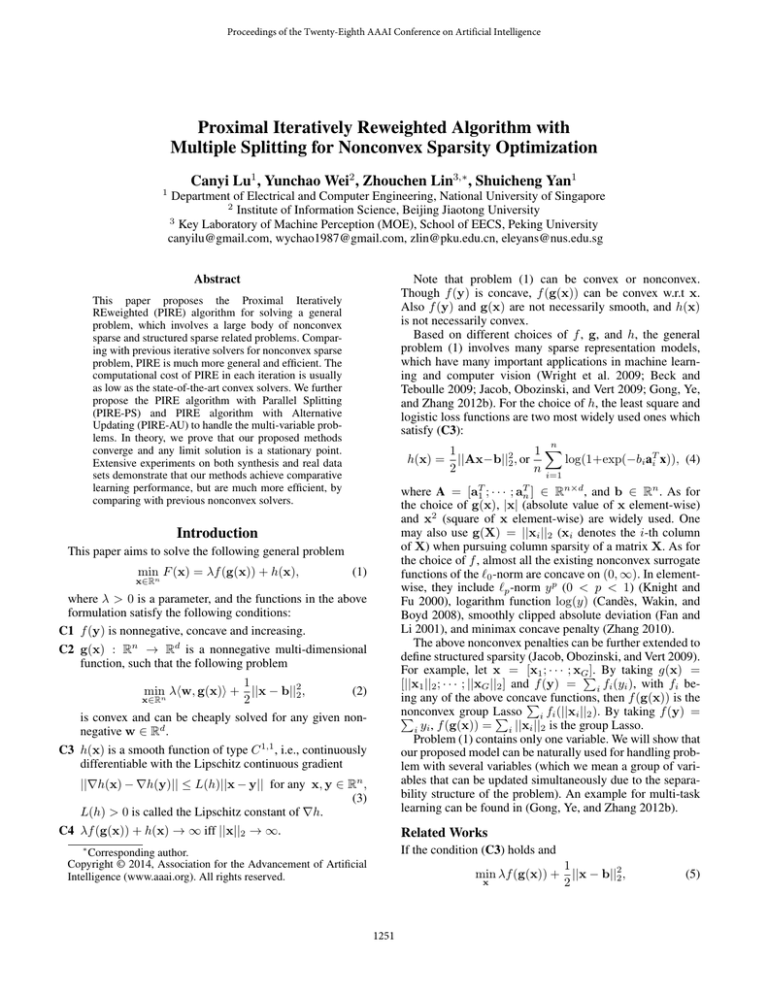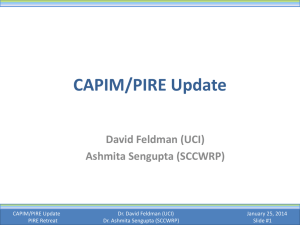
Proceedings of the Twenty-Eighth AAAI Conference on Artificial Intelligence
Proximal Iteratively Reweighted Algorithm with
Multiple Splitting for Nonconvex Sparsity Optimization
Canyi Lu1 , Yunchao Wei2 , Zhouchen Lin3,∗ , Shuicheng Yan1
1
Department of Electrical and Computer Engineering, National University of Singapore
2
Institute of Information Science, Beijing Jiaotong University
3
Key Laboratory of Machine Perception (MOE), School of EECS, Peking University
canyilu@gmail.com, wychao1987@gmail.com, zlin@pku.edu.cn, eleyans@nus.edu.sg
Abstract
Note that problem (1) can be convex or nonconvex.
Though f (y) is concave, f (g(x)) can be convex w.r.t x.
Also f (y) and g(x) are not necessarily smooth, and h(x)
is not necessarily convex.
Based on different choices of f , g, and h, the general
problem (1) involves many sparse representation models,
which have many important applications in machine learning and computer vision (Wright et al. 2009; Beck and
Teboulle 2009; Jacob, Obozinski, and Vert 2009; Gong, Ye,
and Zhang 2012b). For the choice of h, the least square and
logistic loss functions are two most widely used ones which
satisfy (C3):
n
1
1X
h(x) = ||Ax−b||22 , or
log(1+exp(−bi aTi x)), (4)
2
n i=1
This paper proposes the Proximal Iteratively
REweighted (PIRE) algorithm for solving a general
problem, which involves a large body of nonconvex
sparse and structured sparse related problems. Comparing with previous iterative solvers for nonconvex sparse
problem, PIRE is much more general and efficient. The
computational cost of PIRE in each iteration is usually
as low as the state-of-the-art convex solvers. We further
propose the PIRE algorithm with Parallel Splitting
(PIRE-PS) and PIRE algorithm with Alternative
Updating (PIRE-AU) to handle the multi-variable problems. In theory, we prove that our proposed methods
converge and any limit solution is a stationary point.
Extensive experiments on both synthesis and real data
sets demonstrate that our methods achieve comparative
learning performance, but are much more efficient, by
comparing with previous nonconvex solvers.
where A = [aT1 ; · · · ; aTn ] ∈ Rn×d , and b ∈ Rn . As for
the choice of g(x), |x| (absolute value of x element-wise)
and x2 (square of x element-wise) are widely used. One
may also use g(X) = ||xi ||2 (xi denotes the i-th column
of X) when pursuing column sparsity of a matrix X. As for
the choice of f , almost all the existing nonconvex surrogate
functions of the `0 -norm are concave on (0, ∞). In elementwise, they include `p -norm y p (0 < p < 1) (Knight and
Fu 2000), logarithm function log(y) (Candès, Wakin, and
Boyd 2008), smoothly clipped absolute deviation (Fan and
Li 2001), and minimax concave penalty (Zhang 2010).
The above nonconvex penalties can be further extended to
define structured sparsity (Jacob, Obozinski, and Vert 2009).
For example, let x = [x1 ; · · · ; xGP
]. By taking g(x) =
[||x1 ||2 ; · · · ; ||xG ||2 ] and f (y) =
i fi (yi ), with fi being any of the above concave
P functions, then f (g(x)) is the
nonconvex
group Lasso
i fi (||xi ||2 ). By taking f (y) =
P
P
y
,
f
(g(x))
=
||x
||
i
i
2 is the group Lasso.
i
i
Problem (1) contains only one variable. We will show that
our proposed model can be naturally used for handling problem with several variables (which we mean a group of variables that can be updated simultaneously due to the separability structure of the problem). An example for multi-task
learning can be found in (Gong, Ye, and Zhang 2012b).
Introduction
This paper aims to solve the following general problem
min F (x) = λf (g(x)) + h(x),
x∈Rn
(1)
where λ > 0 is a parameter, and the functions in the above
formulation satisfy the following conditions:
C1 f (y) is nonnegative, concave and increasing.
C2 g(x) : Rn → Rd is a nonnegative multi-dimensional
function, such that the following problem
1
minn λhw, g(x)i + ||x − b||22 ,
(2)
x∈R
2
is convex and can be cheaply solved for any given nonnegative w ∈ Rd .
C3 h(x) is a smooth function of type C 1,1 , i.e., continuously
differentiable with the Lipschitz continuous gradient
||∇h(x) − ∇h(y)|| ≤ L(h)||x − y|| for any x, y ∈ Rn ,
(3)
L(h) > 0 is called the Lipschitz constant of ∇h.
C4 λf (g(x)) + h(x) → ∞ iff ||x||2 → ∞.
Related Works
If the condition (C3) holds and
∗
Corresponding author.
Copyright © 2014, Association for the Advancement of Artificial
Intelligence (www.aaai.org). All rights reserved.
1
min λf (g(x)) + ||x − b||22 ,
x
2
1251
(5)
can be cheaply computed, then problem (1) can be solved
by iteratively solving a series of problem (5) (Gong et al.
2013). Such an updating procedure is the same as the ISTA
algorithm (Beck and Teboulle 2009), which is originally
for convex optimization. It can be proved that any accumulation point of {xk } is a stationary point of problem (1).
If f (g(x)) and h(x) are convex, the Fast ISTA algorithm
(FISTA) (Beck and Teboulle 2009) converges to the globally optimal solution with a convergence rate O(1/T 2 ) (T is
the iteration number). But for nonconvex optimization, it is
usually very difficult to get the globally optimal solution to
problem (5). Sometimes, it is also not easy even if f (g(x))
is convex.
The multi-stage algorithm in (Zhang 2008) solves problem (1) by solving a series of convex problem.
min λhwk , g(x)i + h(x).
x
Another related work is (Lu 2012) which aims to solve
min λ
x
1
min λhwk , |x|i + ||x − b||22 .
(13)
x
2
But their solver is only for problem (12) which is a special
case of (1). The convergence proofs also depend on the special property of the `p -norm, thus is not general.
Furthermore, previous iterative algorithms can only solve
the problem with only one variable. They cannot be naively
generalized to solve multi-variable problems. However,
there are many problems involving two or more variables,
e.g. stable robust principle component analysis (Zhou et al.
2010) and robust multi-task feature learning (Gong, Ye, and
Zhang 2012b). So it is desirable to extend the iteratively
reweighted algorithms for the multi-variable case.
(6)
Contributions
In this work, we propose a novel method to solve the general
problem (1), and address the scalablity and multi-variable
issues. In each iteration we only need to solve problem
(2), whose computational cost is usually the same as previous state-of-the-art first-order convex methods. This method
is named as Proximal Iteratively REweighted (PIRE) algorithm. We further propose two multiple splitting versions of PIRE: PIRE with Parallel Splitting (PIRE-PS) and
PIRE with Alternative Updating (PIRE-AU) to handle the
multi-variable problem. Parallel splitting makes the algorithm highly parallelizable, making PIRE-PS suitable for
distributed computing. This is important for large scale applications. PIRE-AU may converge faster than PIRE-PS. In
theory, we prove that any sequences generated by PIRE,
PIRE-PS and PIRE-AU are bounded and any accumulation
point is a stationary point. To the best of our knowledge,
PIRE-PS and PIRE-AU are the first two algorithms for problem (1) with multi-variables. If problem (1) is convex, the
obtained solution is globally optimal.
1
min λ||x||pp + ||Ax − b||22 .
(7)
x
2
The above problem is NP-hard. IRL1 instead considers the
following relaxed problem
x
n
X
1
(|xi | + )p + ||Ax − b||22 ,
2
i=1
(8)
with 0 < 1. IRL1 updates xk+1 by solving
xk+1 = arg min λ
x
n
X
1
wik |xi | + ||Ax − b||22 ,
2
i=1
(9)
with wik = p/(|xki | + )1−p
P. Problem p(8) is a special case
of (1) by letting f (y) =
i (yi + ) (0 < p < 1) and
g(x) = |x|. However, IRL1 is not efficient since it has to
solve a number of nonsmooth problem (9) by using some
other convex optimization methods, e.g. FISTA.
The other method, IRLS, smooths problem (7) as
n
X
p
1
min λ
(x2i + ) 2 + ||Ax − b||22 ,
2
i=1
(12)
i=1
In each iteration, x is efficiently updated by solving a series
of problem
However, solving such a convex problem requires other iterative solvers which is not efficient. It also fails when h(x) is
nonconvex.
More specially, the Iteratively Reweighted L1 (IRL1)
(Chen and Zhou ) and Iteratively Reweighted Least Squares
(IRLS) (Lai, Xu, and Yin 2013) algorithms are special cases
of the multi-stage algorithm. They aim to solve the following `p -regularization problem
min λ
n
X
(|xi | + )p + h(x).
Proximal Iteratively Reweighted Algorithm
In this section, we show how to solve problem (1) by our
Proximal Iteratively Reweighted (PIRE) algorithm. Instead
of minimizing F (x) in (1) directly, we update xk+1 by minimizing the sum of two surrogate functions, which correspond to two terms of F (x), respectively.
First, note that f (y) is concave, −f (y) is convex. By the
definition of subgradient of the convex function, we have
(10)
and updates xk+1 by solving
λDiag(wk )x + AT (Ax − b) = 0,
(11)
p
1−
2
with wik = p/ (xki )2 + . Problem (10) is also a speP
p
cial case of (1) by taking f (y) = i (yi + ) 2 and g(x) =
x2 . However, the obtained solution by IRLS may not be
naturally sparse, or it may require a lot of iterations to get
a sparse solution. One may perform thresholding appropriately to achieve a sparse solution, but there is no theoretically sound rule to suggest a correct threshold.
−f (g(x)) ≥ −f (g(xk )) + h−wk , g(x) − g(xk )i, (14)
where −wk is the subgradient of −f (y) at y = g(xk ), i.e.
−wk ∈ ∂ −f (g(xk )) or wk ∈ −∂ −f (g(xk )) . (15)
Eqn (14) is equivalent to
f (g(x)) ≤ f (g(xk )) + hwk , g(x) − g(xk )i.
1252
(16)
(2) The sequence {xk } is bounded;
∞
P
2D
(3)
||xk − xk+1 ||2F ≤ 2µ−L(h)
. In particular, we have
Algorithm 1 Solving problem (1) by PIRE
L(h)
2 ,
Input: µ >
where L(h) is the Lipschitz constant of h(x).
Initialize: k = 0, wk .
Output: x∗ .
while not converge do
k=1
lim (xk − xk+1 ) = 0.
k→∞
Proof. Since xk+1 is the globally optimal solution to
problem (18), the zero vector is contained in the subgradient with respect to x. That is, there exists vk+1 ∈
∂hwk , g(xk+1 )i such that
1. Update xk+1 by solving the following problem
k+1
x
k
= arg min λhw , g(x)i +
x
2
µ
x − xk − 1 ∇h(xk ) .
2
µ
2. Update the weight wk+1 by
w
k+1
λvk+1 + ∇h(xk ) + µ(xk+1 − xk ) = 0.
k+1
∈ −∂ −f (g(x
)) .
A dot-product with xk+1 − xk on both sides of (19) gives
λ vk+1 , xk+1 − xk + ∇h(xk ), xk+1 − xk
(20)
+ µ||xk+1 − xk ||2 = 0.
end while
Then f (g(xk )) + hwk , g(x) − g(xk )i is used as a surrogate
function of f (g(x)).
The loss function h(x), which has Lipschitz continuous
gradient, owns the following property (Bertsekas 1999)
h(x) ≤ h(y) + h∇h(y), x − yi +
(19)
Recalling the definition of the subgradient of the convex
function, we have
hwk , g(xk ) − g(xk+1 )i ≥ vk+1 , xk − xk+1 . (21)
L(h)
||x − y||22 . (17)
2
Combining (20) and (21) gives
k 2
Let y = xk , h(xk ) + h∇h(xk ), x − xk i + L(h)
2 ||x − x ||2
is used as a surrogate function of h(x).
Combining (16) and (17), we update xk+1 by minimizing
the sum of these two surrogate functions
λhwk , g(xk ) − g(xk+1 )i
≥ − ∇h(xk ), xk − xk+1 + µ||xk+1 − xk ||2 .
(22)
Since f is concave, similar to (16), we get
xk+1
f (g(xk )) − f (g(xk+1 )) ≥ hwk , g(xk ) − g(xk+1 )i. (23)
= arg min f (g(xk )) + hwk , g(x) − g(xk )i
x
By the condition (C3), we have
µ
+ h(xk ) + h∇h(xk ), x − xk i + ||x − xk ||22
2
2
1
µ
k
k
k
= arg min λhw , g(x)i + x − x − ∇h(x ) ,
x
2
µ
2
(18)
h(xk ) − h(xk+1 )
L(h) k+1
≥ ∇h(xk ), xk − xk+1 −
||x
− xk ||2 .
2
Now, combining (22)(23) and (24), we have
where wk is also called the weight corresponding to g(xk ).
For the choice of µ in (18), our theoretical analysis shows
that µ > L(h)/2 guarantees the convergence of the proposed algorithm. Note that f is concave and increasing, this
guarantees that wk in (15) is nonnegative. Usually problem
(18) can be cheaply computed based on the condition (C2).
For example, if g(x) = |x|, solving problem (18) costs only
O(n). Such computational cost is the same as the state-ofthe-art convex solvers for `1 -minimization. This idea leads
to the Proximal Iteratively REweighted (PIRE) algorithm, as
shown in Algorithm 1. In the next section, we will prove that
the sequence generated by PIRE is bounded and any accumulation point is a stationary point of problem (1).
(24)
F (xk ) − F (xk+1 )
=λf (g(xk )) − λf (g(xk+1 )) + h(xk ) − h(xk+1 )
L(h)
||xk+1 − xk ||2 ≥ 0.
≥ µ−
2
(25)
Hence F (xk ) is monotonically decreasing. Summing all the
above inequalities for k ≥ 1, it follows that
∞
L(h) X k+1
1
D = F (x ) ≥ µ −
||x
− xk ||2 . (26)
2
k=1
k+1
This implies that lim (x
k→∞
Convergence Analysis of PIRE
− xk ) = 0. Also {xk } is
bounded due to the condition (C4).
k
Theorem 2. Let {x } be the sequence generated in Algorithm 1. Then any accumulation point of {xk } is a stationary
point x∗ of problem (1). Furthermore, for every n ≥ 1, we
have
L(h)
2 ,
Theorem 1. Let D = F (x1 ), and µ >
where L(h)
is the Lipschitz constant of h(x). The sequence {xk } generated in Algorithm 1 satisfies the following properties:
(1) F (xk ) is monotonically decreasing. Indeed,
L(h)
k
k+1
F (x ) − F (x
)≥ µ−
||xk − xk+1 ||2 ;
2
min ||xk+1 − xk ||22 ≤
1≤k≤n
1253
F (x1 ) − F (x∗ )
.
n µ − L(h)
2
(27)
s = 1, · · · , S, can be updated in parallel. This is known
as Jacobi iteration in numerical algebra (Liu, Lin, and Su
2013). This algorithm is named as PIRE with Parallel Splitting (PIRE-PS). Actually the updating rule of PIRE-PS is
the same as PIRE, but in parallel. It is easy to check that the
proofs in Theorem 1 and 2 also hold for PIRE-PS.
For some special cases of h(x1 , · · · , xS ), we can use
different µs , usually smaller than µ, for updating xk+1
.
s
This may lead to faster convergence (Zuo and Lin 2011).
2
P
S
If h(x1 , · · · , xS ) = 12 s=1 As xs − b , we can update
Please refer to the Supplementary Material for the proof.
We conclude this section with the following remarks:
(1) When proving the convergence of IRL1 for solving
problem (8) or (12) in (Chen and Zhou ; Lu 2012), they
use the Young’s inequality which is a special property
of the function y p (0 < p < 1)
n
X
| + )p ≥
(|xki | + )p − (|xk+1
i
i=1
n
X
wik xki − xk+1
,
i
i=1
(28)
where wik = p/(|xki | + )1−p . Eqn (28) is a special case
of (23). But (23) is obtained by using the concavity of
f (y), which is much more general.
(2) In Eqn (27), ||xk+1 − xk ||2 is used to measure the
convergence rate of the algorithm. The reason is that
||xk+1 − xk ||2 → 0 is a necessary optimality condition
as shown in the Theorem 1.
(3) PIRE requires that µ > L(h)/2. But sometimes the
Lipschitz constant L(h) is not known, or it is not computable for large scale problems. One may use the backtracking rule to estimate µ in each iteration (Beck and
Teboulle 2009). PIRE with multiple splitting shown in
the next section also eases this problem.
xk+1
by
s
2
xk+1
= arg min λhwsk , gs (xs )i
s
xs
2 (32)
µs xs − xks − 1 ATs (Axk − b ,
+
2
µs
2
PIRE with Multiple Splitting
where µs > Ls (h)/2 and Ls (h) = ||As ||22 is the Lipschitz
constant of ∇s h(x1 , · · · , xS ). If the size of A is very large,
L(h) = ||A||22 may not be computable. We can split it to
A = [A1 , · · · , AS ], and compute each Ls (h) = ||As ||22
instead. Similar convergence results in Theorem 1 and 2 also
hold by updating xk+1
in (32). For detailed proofs, please
s
refer to the Supplementary Material. A main difference of
the convergence poof is that we use the Pythagoras relation
In this section, we will show that PIRE can also solve multivariable problem as follows
||a − c||22 − ||b − c||22 = ||a − b||22 + 2ha − b, b − ci, (33)
min F (x) = λ
x1 ,··· ,xS
S
X
for the squared loss h(x1 , · · · , xS ). This property is much
tighter than the property (17) of function with Lipschitz continuous gradient.
The result that using the squared loss leads to smaller Lipschitz constants by PIRE-PS is very interesting and useful.
Intuitively, it results to minimize a tighter upper bounded
surrogate function. Our experiments show that this will lead
to a faster convergence of the PIRE-PS algorithm.
fs (gs (xs )) + h(x1 , · · · , xS ), (29)
s=1
where fs and gs holds the same assumptions as f and g in
problem (1), respectively. Problem (29) is similar to problem
(1), but splits x into x = [x1 ; · · · ; xS ] ∈ Rn , where xs ∈
PS
Rns , and i=1 ns = n.
Based on different assumptions of h(x1 , · · · , xS ), we
have two splitting versions of the PIRE algorithm. They use
different updating orders of the variables.
PIRE with Alternative Updating
In this section, we propose another splitting method to
solve problem (29) based on the assumption that each
∇s h(x1 , · · · , xS ) is Lipschitz continuous with constant
Ls (h). Different from PIRE-PS, which updates each xk+1
s
based on xks , s = 1, · · · , S, we instead update xk+1
based
s
on all the latest xs . This is the known Gauss-Sidel iteration
in numerical algebra. We name this method as PIRE with
Alternative Updating (PIRE-AU).
Since ∇s h(x1 , · · · , xS ) is Lipschitz continuous, similar
to (17), we have
PIRE with Parallel Splitting
If we still assume that (C3) holds, i.e. h(x1 , · · · , xS ) has a
Lipschitz continuous gradient, with Lipschitz constant L(h),
PIRE is naturally parallelizable. In each iteration, we parallelly update xk+1
by
s
xk+1
= arg min λhwsk , gs (xs )i
s
xs
2
µ
1
k
k
k
,
+ ∇
h
x
,
·
·
·
,
x
x
−
x
−
s
s
s
1
S
2
µ
(30)
k
k
h(xk+1
, · · · , xk+1
1
s−1 , xs , xs+1 , · · · , xS )
k
k
≤h(xk+1
, · · · , xk+1
1
s−1 , xs , · · · , xS )+
where the notion ∇s h (x1 , · · · , xS ) denotes the gradient
w.r.t xs , µ > L(h)/2, and wsk is the weight vector corresponding to g(xks ), which can be computed by
wsk ∈ −∂ −fs (gs (xks )) , s = 1, · · · , S.
(31)
k
k
k
h∇s h(xk+1
, · · · , xk+1
1
s−1 , xs , · · · , xS ), xs − xs i
Ls (h)
+
||xs − xks ||22 .
2
(34)
The hand right part of (34) is used as a surrogate function
k
k
of h(xk+1
, · · · , xk+1
1
s−1 , xs , xs+1 , · · · , xS ), which is tighter
When updating xs in the (k + 1)-th iteration, only the variables in the k-th iteration are used. Thus the variables xk+1
,
s
1254
5
4
3
6
5
8
PIRE
PIRE-PS
PIRE-AU
IRLS
IRL1
0.2
0.4
0.6
p value
0.8
1
4
3
(a)
1
0
x 10
7
6
5
Table 1: Comparison of iteration number, running time (in sec-
PIRE
PIRE-PS
PIRE-AU
IRLS
IRL1
onds), objective function value and relative recovery error of different iterative reweighted methods.
4
3
Size (m, n, t)
Methods
Iter.
PIRE
PIRE-PS
PIRE-AU
IRLS
IRL1
PIRE
PIRE-PS
PIRE-AU
IRLS
IRL1
PIRE
PIRE-PS
PIRE-AU
IRLS
IRL1
PIRE
PIRE-PS
PIRE-AU
IRLS
IRL1
PIRE
PIRE-PS
PIRE-AU
IRLS
IRL1
116
58
56
168
56
119
37
36
169
81
151
29
28
171
79
159
26
25
171
89
140
33
32
177
112
2
2
2
1
0
x 10
7
Relative error
Relative error
6
8
PIRE
PIRE-PS
PIRE-AU
IRLS
IRL1
Relative error
x 10
7
-3
-3
-3
8
0.2
0.4
0.6
p value
0.8
(b)
1
1
0
0.2
0.4
0.6
p value
0.8
1
(100,500,50)
(c)
Figure 1: Recovery performance comparison with a different
(200,800,100)
number of measurement A ∈ Rm×1000 : (a) m = 200; (b)
m = 300; and (c) m = 400.
(300,1000,200)
than (17) in PIRE. Then we update xk+1
by
s
µ
s
xk+1
= arg min λhwsk , gs (xs )i + ||xs − xks ||22 .
s
xs
2
k
k
k
+ h∇s h(xk+1
, · · · , xk+1
1
s−1 , xs , · · · , xS ), xs − xs i,
(35)
(500,1500,200)
( 800,2000,200)
where µs > Ls (h)/2 and wsk is defined in (31).
The updating rule in PIRE-AU by (35) and (31) also leads
to converge. Any accumulation point of {xk } is a stationary
point. See the detailed proofs in the Supplementary Material.
Both PIRE-PS and PIRE-AU can solve the multi-variable
problems. The advantage of PIRE-PS is that it is naturally
parallelizable, while PIRE-AU may converge with less iterations due to smaller Lipschitz constants. If the squared loss
function is used, PIRE-PS use the same small Lipschitz constants as PIRE-AU.
Time
(second).
0.70
0.48
0.63
81.82
3.43
1.48
0.82
0.88
474.19
13.53
4.63
1.38
1.34
1298.70
35.59
8.88
2.27
2.20
3451.79
80.89
14.99
5.15
4.97
7211.2
173.26
Obj.
(×10−2 )
5.238
5.239
5.239
5.506
5.239
16.923
16.919
16.919
17.784
16.924
42.840
42.815
42.815
44.937
42.844
64.769
64.718
64.718
67.996
64.772
87.616
87.533
87.533
91.251
87.617
Recovery error
(×10−3 )
2.529
2.632
2.632
2.393
2.546
2.246
2.192
2.192
2.142
2.248
2.118
1.978
1.977
2.015
2.124
2.010
1.814
1.814
1.923
2.013
1.894
1.648
1.648
1.851
1.895
loop iteration, which is the main cost for IRL1. For PIRE-PS
and PIRE-AU algorithms, we solve problem (29) by setting
S = 20.
Sparse Signal Recovery The first experiment is to examine the recovery performance of sparse signals by using
the proposed methods. The setup for each trial is as follows. The dictionary A ∈ Rm×n is a Gaussian random matrix generated by Matlab command randn, with the sizes
m = 200, 300, 400, and n = 1000. The sparse signal x
is randomly generated with sparsity ||x||0 = 20. The response b = Ax + 0.01e, where e is Gaussian random
vector. Given A and b, we can recover x̂ by solving the
`p -minimization problem by different methods. The parameter is set to λ = 10−4 . We use the relative recovery error
||x̂−x||2 /||x||2 to measure the recovery performance. Based
on the above settings and generated data, we find that the recovery performances are stable. We run 20 trials and report
the mean relative error for comparison.
Figure 1 plots the relative recovery errors v.s. different p
values (p = 0.1, · · · , 0.9, 1) on three data sets with different
numbers of measurements. The result for p = 1 is obtained
by FISTA for `1 -minimization. We can see that all the iteratively reweighted algorithms achieve better recovery performance with p < 1 than `1 -minimization. Also a smaller
value of p leads to better recovery performance, though the
`p -minimization problem is nonconvex and a globally optimal solution is not available. In most cases, PIRE is comparative with IRLS and IRL1. A surprising result is that
PIRE-PS and PIRE-AU outperform the other methods when
0.5 < p < 1. They use a smaller Lipschitz constant than
PIRE, and thus may converge faster. But none of these iteratively reweighted methods is guaranteed to be optimal.
Experiments
We present several numerical experiments to demonstrate
the effectiveness of the proposed PIRE algorithm and its
splitting versions. All the algorithms are implemented by
Matlab, and are tested on a PC with 8 GB of RAM and Intel
Core 2 Quad CPU Q9550.
`p -Minimization
We compare our proposed PIRE, PIRE-PS and PIREAU algorithms with IRLS and IRL1 for solving the `p minimization problem (7). For fair comparison, we try to
use the same settings of all the completed algorithms. We
use the solution to the `1 -minimization problem as the initialization. We find that this will accelerate the convergence of the iteratively reweighted algorithms, and also enhance the recovery performance. The choice of in (8)
and (10) plays an important role for sparse signal recovery, but theoretical support has not been carried out so far.
Several different decreasing rules have been tested before
(Candès, Wakin, and Boyd 2008; Mohan and Fazel 2012;
Lai, Xu, and Yin 2013), but none of them dominates others.
Since the sparsity of sparse signal is usually unknown, we
empirically set k+1 = k /ρ, with 0 = 0.01, and ρ = 1.1
(Mohan and Fazel 2012). The algorithms are stopped when
||xk − xk+1 ||2 /||xk ||2 ≤ 10−6 .
IRL1 requires solving (9) as inner loop. FISTA is employed to solve (9) with warm start, i.e. using xk as initialization to obtain xk+1 . This trick greatly reduces the inner
Running Time Comparison The second experiment is to
show the advantage in running time of the proposed methods. We implement all the completed methods in matrix
1255
3.5
3 0
10
1
10
2
10
3
10
Running time (log scaled)
12
11.5
11
10.5
10 0
10
1
10
2
10
(a)
3
10
Running time (log scaled)
0.4
38
50
37.5
Multi-Stage
PIRE
PIRE-PS
PIRE-AU
0.3
37
36.5
PIRE
PIRE-PS
PIRE-AU
36
35.5 0
10
1
10
0.1
3
2
10
10
0.2
Running time (log scaled)
(b)
0
(c)
Figure 2: Running time v.s. objective function value on three
0.1
0.3
0.2
Training Ratio
Running time (s)
4
PIRE
PIRE-PS
PIRE-AU
IRL1
12.5
MSE
4.5
13
Objective function value
PIRE
PIRE-PS
PIRE-AU
IRL1
Objective function value
Objective function value
5
40
Multi-Stage
PIRE
PIRE-PS
PIRE-AU
30
20
10
0
0.1
0.3
0.2
Training Ratio
(a)
synthesis data sets with size (m, n, t): (a) (1000,3000,500); (b)
(1000,5000,1000); (c) (1000,10000,1000).
(b)
Figure 3: Comparison of (a) mean squared error (MSE) and running time on the Isolet data set for multi-task feature learning.
form for solving the following `p -minimization problem
1
min λ||X||pp + ||AX − B||2F ,
n×t
2
X∈R
The Isolet (Bache and Lichman 2013) data set is used in
our test. 150 subjects spoke the name of each letter of the
alphabet twice. Hence, we have 52 training examples from
each speaker. The speakers are grouped into 5 subsets of 30
speakers each. Thus, we have 5 tasks with each task corresponding to a subset. There are 1560, 1560, 1560, 1558, and
1559 samples of 5 tasks, respectively. The data dimension is
617, and the response is the English letter label (1-26). We
randomly select the training samples from each task with
different training ratios (0.1, 0.2 and 0.3) and use the rest of
samples to form the test set. We compare our PIRE, PIRE-PS
and PIRE-AU (we set S = m = 5 in PIRE-PS and PIREAU) with the Multi-Stage algorithm (Zhang 2008). We report the Mean Squared Error (MSE) on the test set and the
running time for solving (37) on the training set. The results
are averaged over 10 random splittings. As shown in Figure
3, it can be seen that all these methods achieve comparative performance, but our PIRE, PIRE-PS and PIRE-AU are
much more efficient than the Multi-Stage algorithm.
(36)
P
where A ∈ Rm×n and B ∈ Rm×t , ||X||pp = ij |Xij |p ,
and p is set to 0.5 in this test. A, B and X are generated by
the same procedure as the above section, and the same settings of algorithm parameters are followed. Each column of
X is with sparsity n × 2%. We test on several different sizes
of data sets, parameterized as (m, n, t). The iteration number, running time, objective function value and the relative
recovery error are tabulated in Table 1. It can be seen that
the proposed methods are much more efficient than IRLS
and IRL1. PIRE-PS and PIRE-AU converge with less iteration and less running time. In our test, IRL1 is more efficient
than IRLS. The reasons lie in: (1) initialization as a sparse
solution to `1 -minimization is a good choice for IRL1, but
not for IRLS; (2) For each iteration in IRLS, solving t equations (11) in a loop by Matlab is not efficient; (3) IRL1 converges with less inner loop iterations due to warm start.
We also plot the running time v.s. objective function value
on three larger data sets in Figure 2. The algorithms are
stopped within 500 seconds in this test. IRLS costs much
more time, and thus it is not plotted. IRL1 is not plotted for
the case n = 10, 000. It can be seen that PIRE-PS and PIREAU decreases the objective function value faster than PIRE.
Conclusions
This paper proposes the PIRE algorithm for solving the general problem (1). PIRE solves a series of problem (2), whose
computational cost is usually very cheap. We further propose two splitting versions of PIRE to handle the multivariable problems. In theory, we prove that PIRE (also its
splitting versions) converges and any limit point is a stationary point. We test our methods to solve the `p -minimization
problem and multi-task feature learning problem. Experimental results on both synthesis and real data sets show that
our methods are with comparative learning performance, but
much more efficient, by comparing with IRLS and IRL1
or multi-stage algorithms. It would be interesting to apply
PIRE for structured sparsity optimization, and also the nonconvex low rank regularized minimization problems (Lu et
al. 2014).
Multi-Task Feature Learning
In this experiment, we use our methods to solve the multitask learning problem. Assume we are given m learning
tasks associated with {(X1 , y1 ), · · · , (Xm , ym )}, where
Xi ∈ Rni ×d is the data matrix of the i-th task with each
row a sample, yi ∈ Rni is the label of the i-th task, ni is the
number of samples for the i-th task, and d is the data dimension. Our goal is to find a matrix Z = [z1 , · · · , zm ] ∈ Rd×m
such that yi ≈ Xi zi . The capped-`1 norm is used to regularize Z (Gong, Ye, and Zhang 2012a)
min λ
Z
d
X
min(||zj ||1 , θ) + h(Z),
(37)
Acknowledgements
j=1
This research is supported by the Singapore National Research Foundation under its International Research Centre @Singapore Funding Initiative and administered by the
IDM Programme Office. Z. Lin is supported by NSF of
China (Grant nos. 61272341, 61231002, and 61121002) and
MSRA.
Pm
where h(Z) = i=1 ||Xi zi − yi ||22 /mni is the loss function, θ > 0 is the thresholding parameter, and zj is the j-th
row of Z. The above problem can be solved by our proposed
PIRE, PIRE-PS and PIRE-AU algorithms, by letting f (y) =
Pd
1
m
j=1 min(yi , θ), and g(Z) = [||z ||1 ; · · · ; ||z ||1 ].
1256
References
Zuo, W., and Lin, Z. 2011. A generalized accelerated
proximal gradient approach for total-variation-based image
restoration. TIP 20(10):2748–2759.
Bache, K., and Lichman, M. 2013. UCI machine learning
repository. http://archive.ics.uci.edu/ml.
Beck, A., and Teboulle, M. 2009. A fast iterative shrinkagethresholding algorithm for linear inverse problems. SIAM
Journal on Imaging Sciences 2(1):183–202.
Bertsekas, D. P. 1999. Nonlinear programming. Athena
Scientific (Belmont, Mass.), 2nd edition.
Candès, E.; Wakin, M.; and Boyd, S. 2008. Enhancing
sparsity by reweighted `1 minimization. Journal of Fourier
Analysis and Applications 14(5):877–905.
Chen, X., and Zhou, W. Convergence of the reweighted `1
minimization algorithm for `2 − `p minimization. to appear
in Comp. Optim. Appl.
Fan, J., and Li, R. 2001. Variable selection via nonconcave
penalized likelihood and its oracle properties. Journal of the
American Statistical Association 96(456):1348–1360.
Gong, P.; Zhang, C.; Lu, Z.; Huang, J.; and Ye, J. 2013.
A general iterative shrinkage and thresholding algorithm for
non-convex regularized optimization problems. ICML.
Gong, P.; Ye, J.; and Zhang, C. 2012a. Multi-stage multitask feature learning. In NIPS.
Gong, P.; Ye, J.; and Zhang, C. 2012b. Robust multi-task
feature learning. In ACM SIGKDD, 895–903. ACM.
Jacob, L.; Obozinski, G.; and Vert, J.-P. 2009. Group Lasso
with overlap and graph Lasso. In ICML, 433–440. ACM.
Knight, K., and Fu, W. 2000. Asymptotics for Lasso-type
estimators. Annals of Statistics 1356–1378.
Lai, M.-J.; Xu, Y.; and Yin, W. 2013. Improved iteratively reweighted least squares for unconstrained smoothed
`q minimization. SIAM Journal on Numerical Analysis
51(2):927–957.
Liu, R.; Lin, Z.; and Su, Z. 2013. Linearized alternating direction method with parallel splitting and adaptive penalty
for separable convex programs in machine learning. In
ACML.
Lu, C.; Tang, J.; Lin, Z.; and Yan, S. 2014. Generalized
nonconvex nonsmooth low-rank minimization. In CVPR.
Lu, Z. 2012. Iterative reweighted minimization methods for
`p regularized unconstrained nonlinear programming. Mathematical Programming.
Mohan, K., and Fazel, M. 2012. Iterative reweighted algorithms for matrix rank minimization. In JMLR, volume 13,
3441–3473.
Wright, J.; Yang, A. Y.; Ganesh, A.; Sastry, S. S.; and Ma,
Y. 2009. Robust face recognition via sparse representation.
TPAMI 31(2):210–227.
Zhang, T. 2008. Multi-stage convex relaxation for learning
with sparse regularization. In NIPS, 1929–1936.
Zhang, C. 2010. Nearly unbiased variable selection under
minimax concave penalty. The Annals of Statistics.
Zhou, Z.; Li, X.; Wright, J.; Candès, E.; and Ma, Y.
2010. Stable principal component pursuit. In IEEE International Symposium on Information Theory Proceedings,
1518–1522. IEEE.
1257







